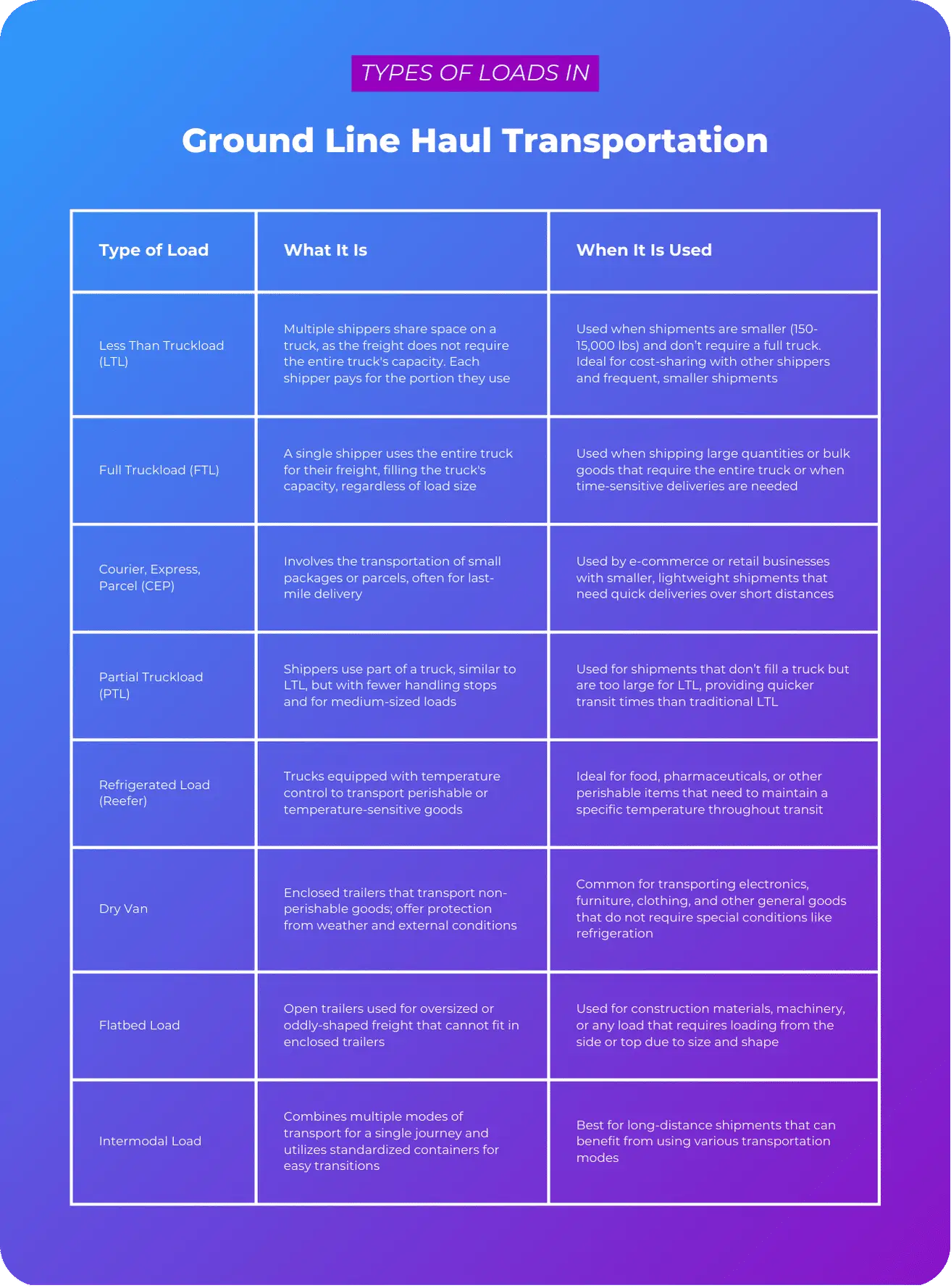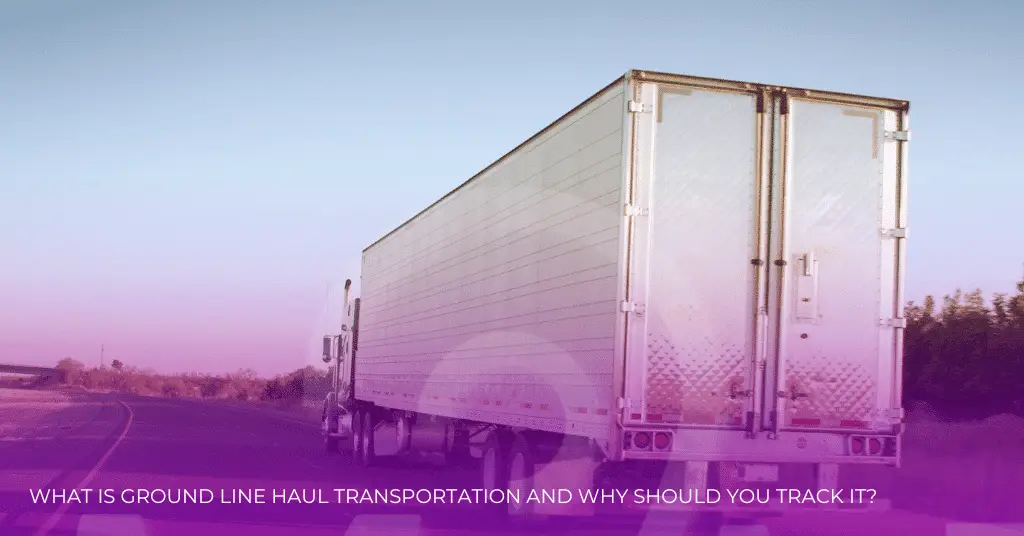يوفر تتبع النقل الأرضي رؤية في الوقت الفعلي لشحناتك، ويمكّن من التسليم بشكل أسرع، ويخفض التكاليف، ويحسن رضا العملاء.
يشير النقل البري إلى نقل البضائع لمسافات طويلة باستخدام الشاحنات أو القطارات. ويتعامل مع مجموعة من الشحنات، من الطرود الصغيرة إلى المنصات الثقيلة، ويستخدمه عادة مزودو خدمات البريد السريع والطرود (CEP)، وشركات النقل التي تقل حمولتها عن حمولة الشاحنة (LTL)، وشركات الخدمات اللوجستية التابعة لجهات خارجية.
عملية نقل البضائع عبر خطوط النقل الأرضية خطوة بخطوة
- استلام البضائع: يقوم مزودو الخدمات اللوجستية بجمع البضائع من المستودعات أو المستودعات أو مراكز التجميع المخصصة.
- التوحيد الأولي: يتم نقل الشحنات المجمعة إلى مستودع مركزي، حيث يتم تجميعها مع البضائع الأخرى المتجهة إلى نفس الوجهة أو المنطقة.
- التحميل للنقل: بعد التجميع، يتم تحميل الشحنة على شاحنات أو مقطورات أو حاويات لنقلها لمسافات طويلة. يتم اختيار وسيلة النقل (على سبيل المثال، الطريق البري أو السكك الحديدية) بناءً على المسافة والحجم ومدى إلحاح الشحنة.
- نقل البضائع على خط الأرض: يتم نقل الشحنة عبر مسافات طويلة، عادةً بين المدن أو المحاور الرئيسية، في هذه المرحلة الأساسية من الرحلة. واعتمادًا على متطلبات الشحنة، قد يتم استخدام وسائل نقل متعددة لتحسين السرعة والتكلفة.
- الوصول إلى مركز التوزيع: بمجرد وصول الشحنة إلى مركز التوزيع، يتم تفريغها في منشأة فرز لمزيد من المعالجة. تعمل هذه المنشأة كنقطة وسط قبل إرسال البضائع إلى وجهتها النهائية.
- الفرز وإعادة التجميع: في المركز، يتم فرز الشحنات وتوحيدها مرة أخرى، هذه المرة للتسليمات المحلية أو الإقليمية بناءً على الوجهات النهائية.
- إرسال للتسليم في الميل الأخير: بعد الفرز، يتم تحميل البضائع على مركبات أصغر حجمًا للتسليم النهائي للعملاء. يغطي هذا النقل في الميل الأخير أقصر جزء من الرحلة: التوصيل إلى المنازل أو المكاتب أو الشركات.
- التسليم في الميل الأخير: يتم إرسال الشحنة المجمعة من مركز التوزيع لـ التسليم في الميل الأخيرتقوم هذه المركبات أو الشاحنات الأصغر حجمًا بتوصيل البضائع إلى وجهاتها النهائية، سواء كانت شركات أو مواقع بيع بالتجزئة أو عناوين سكنية.
- تحليل ما بعد الولادة: يقوم مزودو الخدمات اللوجستية بتحليل أداء التسليم باستخدام البيانات التي يتم جمعها أثناء الرحلة. يساعد هذا في تبسيط العمليات المستقبلية وتحسين المسارات وضمان حلول فعالة من حيث التكلفة للشحنات القادمة.
إن النقل البري أسرع وأكثر فعالية من حيث التكلفة من النقل لمسافات طويلة، والذي ينطوي على نقل البضائع لمسافات طويلة للغاية، وأحيانًا بين البلدان أو القارات. كما تتطلب الشحنات الطويلة المزيد من الموارد وتخضع لتكاليف أعلى بسبب وقت السفر الممتد والبنية الأساسية المشاركة، في حين يركز النقل البري على طرق أقصر وأكثر قابلية للإدارة. وهذا يسمح برحلات أكثر تكرارًا وجداول زمنية يمكن التنبؤ بها وتتبع متقدم، وكل هذا يساهم في كفاءته من حيث التكلفة وسرعته.
علاوة على ذلك، من خلال دمج البضائع ذات الوجهات المتشابهة وتحسين الطرق، يقلل النقل البري من التأخير ويخفض إجمالي نفقات الشحن، وبالتالي فهو الخيار المفضل للشركات التي تريد الحفاظ على سلسلة توريد موثوقة وفي الوقت المناسبوبعبارة بسيطة، فهو يدعم التجارة العالمية من خلال توفير طريقة فعالة لنقل البضائع لمسافات طويلة، ولكن بوتيرة أسرع وبتكلفة أقل مقارنة بالخدمات اللوجستية التقليدية لمسافات طويلة.
طرق أخرى لنقل البضائع بالخطوط
يعد النقل البري معيارًا صناعيًا في المقام الأول بسبب ملاءمته وفعاليته من حيث التكلفة. ولكن هناك طرق أخرى للنقل البري أيضًا.
نقل البضائع بالطائرات
تتضمن عمليات النقل الجوي طائرات شحن وتُستخدم في الشحنات الدولية والعابرة للقارات. هذا النمط هو الأسرع وهو مناسب جدًا للشحنات عالية القيمة أو العاجلة. ومع ذلك، فهو الخيار الأكثر تكلفة للشحن بشكل عام.
النقل البحري
تستخدم خطوط النقل البحري سفن الشحن لنقل البضائع عبر المحيطات. وهو خيار فعال من حيث التكلفة للشحنات الضخمة التي لا تتأثر بالوقت. ورغم أنها أبطأ من النقل الجوي، إلا أنها قادرة على التعامل مع أحجام أكبر بكثير من البضائع.

ما هو تتبع خط النقل الأرضي؟
تتبع خط النقل الأرضي هي عملية مراقبة الشحنات أثناء الجزء الطويل من نقلها. وهي تتضمن استخدام التكنولوجيا لتوفير تحديثات في الوقت الفعلي حول موقع الشحنة وحالتها أثناء تحركها عبر مرحلة النقل على خط النقل في الخدمات اللوجستية.
فيما يلي خمسة جوانب رئيسية لتتبع النقل الأرضي:
- التتبع في الوقت الحقيقي: تتيح هذه الميزة مراقبة مستمرة للموقع الدقيق للشحنة أثناء الرحلة الطويلة. يتيح نظام تحديد المواقع العالمي (GPS) ونظم المعلومات عن بعد لكل من شركة النقل والعميل معرفة مكان وجود البضائع في أي لحظة.
- تحسين المسار: لا يتتبع النظام الموقع فحسب، بل يتتبع أيضًا تقدم الشحنة على طول المسار المخطط له. وقد يقترح أيضًا طرقًا بديلة في حالة الازدحام المروري أو إغلاق الطرق أو الاضطرابات الجوية لضمان التسليم في الوقت المناسب.
- الوقت المقدر للوصول (ETA): توفر أنظمة تتبع خط النقل أيضًا معلومات حول الوقت المقدر لوصول الشحنة. بهذه الطريقة، يكون أصحاب المصلحة دائمًا على علم بالموعد الذي يتوقعون فيه وصول بضائعهم إلى المحور التالي أو الوجهة النهائية.
- تنبيهات الأحداث والمعالم: عندما تمر الشحنات عبر نقاط رئيسية، مثل نقاط التفتيش أو مراكز التوزيع، وما إلى ذلك، يسجل النظام هذه الأحداث ويخطر الشاحن أو العميل بالتقدم. كما يتم أيضًا تحديد التأخيرات أو المشكلات على طول الطريق في الوقت الفعلي.
- الرؤية للعملاء: توفر العديد من شركات النقل البري للعملاء إمكانية الوصول إلى بوابة تتبع، حتى يتمكنوا من متابعة رحلة شحناتهم طوال عملية النقل البري. تضمن هذه الشفافية التخطيط والتنسيق بشكل أفضل على الطرف المتلقي.
10 فوائد رئيسية لتتبع الشحنات الأرضية لأعمالك اللوجستية
تحسين إدارة اتفاقية مستوى الخدمة (SLA)
يتيح التتبع في الوقت الفعلي إمكانية الاطلاع على حالة الشحنات، مما يتيح لشركات الخدمات اللوجستية مراقبة وإدارة الامتثال لاتفاقيات مستوى الخدمة. كما تساعد مقاييس الأداء والتقارير الشركات على تقييم أداء الأسطول وتحديد مجالات التحسين.
حل المشكلة في الوقت المناسب
جيد يحدد نظام تتبع الشحنات بسرعة المشكلات مثل أعطال المركبات أو حوادث الطرق. كما أنه يعمل على تشغيل تنبيهات الإخطار الفورية، مما يتيح لك إرسال فرق الصيانة على الفور أو إعادة توجيه الشحنات لمنع تأخير التسليم وضمان العمليات السلسة.
إعادة التوجيه والجدولة المرنة
إذا كنت من شركات النقل البري، فغالبًا ما تجد صعوبة في إعادة توجيه المسارات عندما تتغير ظروف المرور أو الطقس فجأة. لحسن الحظ، مع وجود نظام جيد لتتبع النقل البري، يمكنك استخدام البيانات في الوقت الفعلي لتعديل المسارات والجداول الزمنية استجابة للظروف غير المتوقعة. تساعد هذه القدرة على التكيف في تقليل الاضطرابات والحفاظ على عمليات التسليم الفعّالة.
الامتثال التنظيمي
يضمن تتبع الشحنات عبر خطوط النقل الأرضية التزام شركات الخدمات اللوجستية باللوائح والقوانين الإقليمية، مثل حدود السرعة أو قيود الوزن. يساعدك هذا على تجنب العقوبات الثقيلة والدعاوى القضائية غير الضرورية.
تجربة أفضل للعملاء
يمكن للعملاء النهائيين أيضًا مراقبة تقدم شحناتهم وتلقي التحديثات في الوقت المناسب. وهذا يؤدي إلى تجربة خدمة أفضل بشكل عام، وبالتالي زيادة رضا العملاء.
إدارة الموارد المُحسّنة
تتيح لك بيانات تتبع النقل البري الدقيقة التخطيط وتخصيص السائقين والمركبات بكفاءة وحكمة. كما يعمل التحسين الفعال للموارد على تقليل التكاليف التشغيلية وتحسين إدارة الأسطول وتعزيز الكفاءة الإجمالية.
زيادة الأمن
من خلال تتبع الشحنات عبر الخط الأرضي، يمكنك أيضًا مراقبة الشحنات بحثًا عن أي انحرافات غير مصرح بها عن خطط الرحلة. وفي حالة وجود أي شكوك بشأن سائق أو مسار معين، يمكنك تشديد إجراءات الأمن والحد من خطر السرقة أو فقدان البضائع.
كفاءة التكلفة
يمكن لشركات الخدمات اللوجستية تحليل أداء الطريق واستهلاك الوقود واتخاذ قرارات مستنيرة لخفض التكاليف وزيادة الربحية.
تواصل أفضل
يُسهِّل التتبع في الوقت الفعلي التواصل بشكل أفضل بين الشاحنين وشركات النقل والعملاء. ويضمن هذا التدفق السلس للمعلومات أن يكون الجميع على نفس الصفحة في جميع الأوقات.
رؤى تعتمد على البيانات
يوفر تتبع النقل الأرضي بيانات وتحليلات قيمة يمكن استخدامها لتقييم اتجاهات الأداء والتنبؤ بالطلب وتجديد استراتيجيات الخدمات اللوجستية.
هل أنت شركة نقل بضائع على الخطوط الأرضية؟
هل تبحث عن تبسيط عملياتك اللوجستية في منتصف الطريق وعبر الحدود؟ يوفر لك برنامج إدارة اللوجستيات المتعددة الوسائط من Mile رؤية شاملة في الوقت الفعلي، ويسهل التعامل مع الشحنات والوثائق في المستودعات، ويضمن سير العمل بشكل أكثر سلاسة من البداية إلى النهاية.
جدولة عرض توضيحي اليوم: https://www.milenow.com/book-demo/

